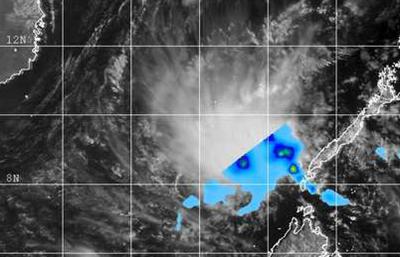NASA sees remnants of TD04W dissipating in South China Sea

This composite image from NASA's TRMM satellite and the MTSAT-2 shows the position of Tropical Depression 04W's remnants in the South China Sea, northwest of Palawan. Credit: NRL/NASA
NASA's Tropical Rainfall Measuring Mission or TRMM satellite passed over the South China Sea on March 25 at 02:56 UTC/March 25 at 10:56 p.m. EDT and gathered data on rainfall rates occurring in the remnants of TD04W.
The image showed that the rainfall associated with the storm had moved away from Palawan and were only falling over the South China Sea.
TRMM's Precipitation Radar instrument showed isolated areas where rain was falling at a rate of 1 inch/25.4 mm per hour.
Over the next several hours, rainfall rates waned as strong easterly wind shear continued to weaken the storm.
By 14:30 UTC/10:30 a.m. EDT on March 25, the Joint Typhoon Warning Center noted that the TD04W's remnants dissipated near 8.8 north and 115.6 east, that's about 540 nautical miles/621.4 miles/1,000 km east of Ho Chi Minh, Vietnam. TD04W is no longer suspect for regeneration.
Media Contact
More Information:
http://www.nasa.govAll latest news from the category: Earth Sciences
Earth Sciences (also referred to as Geosciences), which deals with basic issues surrounding our planet, plays a vital role in the area of energy and raw materials supply.
Earth Sciences comprises subjects such as geology, geography, geological informatics, paleontology, mineralogy, petrography, crystallography, geophysics, geodesy, glaciology, cartography, photogrammetry, meteorology and seismology, early-warning systems, earthquake research and polar research.
Newest articles

A universal framework for spatial biology
SpatialData is a freely accessible tool to unify and integrate data from different omics technologies accounting for spatial information, which can provide holistic insights into health and disease. Biological processes…

How complex biological processes arise
A $20 million grant from the U.S. National Science Foundation (NSF) will support the establishment and operation of the National Synthesis Center for Emergence in the Molecular and Cellular Sciences (NCEMS) at…

Airborne single-photon lidar system achieves high-resolution 3D imaging
Compact, low-power system opens doors for photon-efficient drone and satellite-based environmental monitoring and mapping. Researchers have developed a compact and lightweight single-photon airborne lidar system that can acquire high-resolution 3D…





















